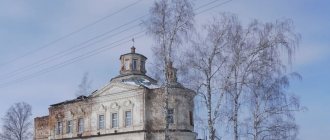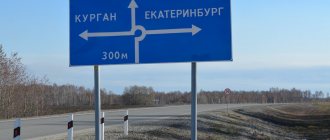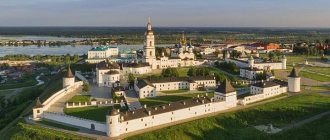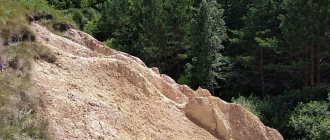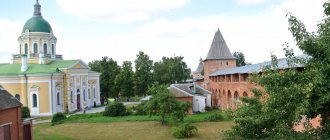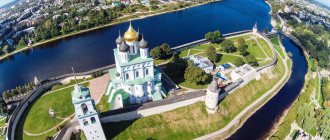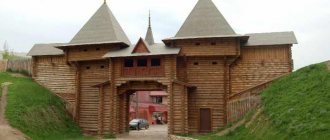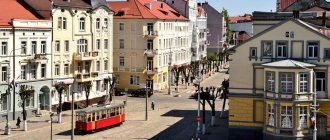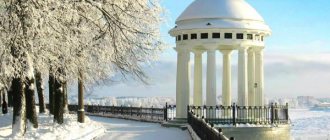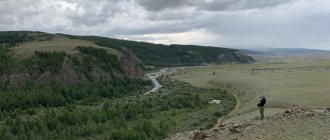It is difficult to imagine that Verkhoturye was once perhaps the largest city in Russia beyond the Ural Range. The city was founded at the end of the 16th century, when there was no Yekaterinburg, no Demidov factories, no mining, and several centuries remained before the heyday of the “supporting edge of the state”. All that happened then was active trade with the northern peoples and the systematic development and annexation of Siberian lands to the Russian kingdom. The famous Verkhoturye customs house was also located here, through which the main trade with the aborigines was carried out and from where significant revenues came to the treasury of the sovereign.
Over time, mining and the growth of industrial production began on the lands of the Urals, which, by definition, brought more money than the trade in sable skins, and the importance of Verkhoturye gradually began to decline.
At this point, the history of the city could have come to an end, but it so happened that about 10 years after the founding of the city, the Verkhoturye Nikolaevsky Monastery was founded here, and about 20 years later - the Intercession Monastery. Later, several more large churches were added to them, and Verkhoturye already received the status of a major spiritual center.
Road
The two most obvious ways to get to Verkhoturye are by bus and railway. But none of them are suitable for a day trip.
Electric trains don’t go here - it’s a bit far, so get there by passenger train going towards the Ob region. The journey will take about 6 hours, but given that this train departs from Yekaterinburg Station in the afternoon, you will only reach the place late in the evening, so you will immediately need to organize an overnight stay. More on this later.
Buses to Verkhoturye run from the Northern Bus Station, but all flights again depart in the afternoon. The journey takes at least 5 hours, so here too there is a problem with spending the night.
Thus, for a one-day voyage, the only options left are either a pilgrim bus, which you simply can’t get on, or personal vehicles.
The road from Yekaterinburg is about 300 km, and with some luck with traffic it can be covered in just over three hours. In total, the journey will take 7-8 hours, and if you leave early, you will have about 5-6 hours left for sightseeing - more than enough.
A two-lane one-way road leads to Nizhny Tagil of quite decent quality, and at the entrance to Tagil it turns into a regular road with oncoming traffic. If in the area of the “city of red sky” traffic is still quite dense, then after the interchange to Verkhnyaya Tura and Krasnouralsk, it becomes completely free.
Before reaching Novaya Lyalya, you will see a large stele “Verkhoturye”. Turn right and after about 22 km you are there. Although no signs were noticed, it will be problematic to drive past the St. Nicholas Monastery - just stay on the main road all the time.
Story
Coat of arms (1783)
Founded in 1598 by the state expedition of Vasily Golovin and Ivan Voeikov as a fort on the site of the previously existing Mansi settlement of Neromkar to protect one of the main waterways to Siberia: up the Kama to Solikamsk, then overland, and then down the Tura to the Ob . Verkhoturye became the main fortress on the way to Siberia. In 1600, a customs house was established, and all Siberian goods passed through the city.
Since the 17th century, a state yam service was established on the Babinovskaya road. The construction of other roads was prohibited. By decree of Peter I in 1708, the state was divided into 8 provinces, the city of Verkhoturye became part of the Siberian province. In 1710, 84 captured Swedes (including 5 pastors) arrived in Verkhoturye.
Verkhoturye in the 2nd half. XVIII century
The city was badly damaged by fires in 1674 and 1738, and its development slowed down in the mid-18th century due to the abolition of customs and the closure of the Verkhotursky tract in 1763.
When the provinces were established, it was a district town in the Siberian province. It was the largest district in Russia - it included almost the entire part of the Urals inhabited by Russians by that time, from Pechora in the north to Ufa in the south, from Vishera and Chusovaya in the west to the tributaries of the Irtysh in the east. In 1783 the city was transferred to the Perm governorate.
In the 19th century, communication routes with Siberia shifted far to the south, and Verkhoturye also lost its commercial importance.
In 1906, traffic opened on the Bogoslovskaya Railway, the station of which was built 8 km from the city.
After the revolution of 1917, the Bolsheviks took power in the city, and from September 1918 to July 1919 Verkhoturye was under the control of Kolchak’s army. In 1926, Verkhoturye lost its city status, which was returned to it only in 1947, in connection with the 350th anniversary of its founding.
Verkhoturye is both the oldest and the smallest city in the Sverdlovsk region.
On February 1, 1963, the city of Verkhoturye was included in the Verkhoturye rural district.
Accommodation in Verkhoturye
The fact that the city is far from a “tourist mecca” is clear, if only by how tight the city is with hotels. In fact, there is only one here - “Sobol”, a hotel with about 50 rooms on the central square, in close proximity to the Verkhoturye Kremlin and the Nikolaevsky Monastery.
This hotel cannot be called cheap: the cost of a room for two people is about 3,000 rubles per night with breakfast. The quality of the rooms is quite acceptable: spacious rooms, wardrobe, TV, unpretentious furniture. But for that kind of money it could have been done better.
There is an outdoor park with a children's playground right in front of the hotel.
Food in Verkhoturye is also not easy. On the territory of the Nikolaevsky Monastery there is a tea shop where you can drink tea and coffee and buy simple pastries. All this is quite affordable - about 50 rubles for two, but that’s all. It was not possible to find anything else edible on the territory of the monastery or the Kremlin, so if possible, take something with you.
Not far from the Monastery there was one dumpling shop, which was closed for special services. And on the second floor of the Sobol Hotel there is a cafe with the pathetic name “Empire-2”, but this is where all the pathos of the establishment ends and the dull provincial service begins. Unhurried staff, a modest selection of dishes that will simply be heated for you in the microwave (at least on the second try, but they will still be heated), and - the same as in the hotel itself - unreasonably high prices. The check for a two-course lunch with drinks was 500 rubles. But you can save money if you first go to the local toilet - your appetite will be completely suppressed.
But, having satisfied our material hunger, let us begin our spiritual hunger. This is much better in Verkhoturye.
Nicholas Monastery
This is one of the two major attractions of Verkhoturye and, perhaps, the oldest religious institution in the Urals. It was founded back in 1604, and 100 years later the relics of Elder Simeon of Verkhoturye were transferred here.
Little is known about Simeon himself, and it is not a fact that during his lifetime this respected man was called that at all. It is only known that he came from a wealthy family in European Russia, who withdrew from worldly life and went to the Urals, where he devoted himself to prayers and serving God. Actually, “social simplification” was the main feat of this man.
He lived in the village of Merkushino, 50 km from Verkhoturye, attended the local church, hunted and died in the middle of the 17th century. However, after about 50 years, the coffin with his body rose from the grave, and the body turned out to be untouched by decay, and several miraculous healings took place at this place. After this, it was decided to transfer the relics of the saint to the St. Nicholas Monastery, and shortly before this, the name Simeon appeared to the abbot of the monastery in a dream. This is how the name of the saint came about - Simeon of Verkhoturye, who, by the way, is also considered the patron saint of fishermen.
After the revolution, a colony for juvenile offenders was organized on the territory of the Nikolaevsky Monastery, which was closed in 1990. A few years later, active restoration of the monastery began with the support of the regional government.
Now work in the monastery is still underway, although it is difficult to understand whether this is construction or renovation. For example, the Holy Cross Cathedral is shrouded in scaffolding.
Since this is a working monastery, certain restrictions apply to visitors: men in shorts, women with bare heads and trousers are not allowed here. Clothing that is too revealing is also not recommended. Scarves and skirts can be obtained for free, but those who are particularly squeamish can buy a new scarf at the church shop.
There are three churches on the territory of the monastery. First of all, this is the Cathedral of the Exaltation of the Cross, which at the time of construction at the beginning of the 20th century was the third largest Orthodox church in Russia after the Cathedral of Christ the Savior in Moscow and St. Isaac's Cathedral in St. Petersburg.
The scale of the temple is still amazing today. however, inside it looks quite modest, especially in comparison with the same CSU and Isaac. In Soviet times, there was either a building materials warehouse or a gym here, the building was not heated and it is not surprising that all the plaster with frescoes simply crumbled into dust. Since the reconstruction, the hands have not yet gotten around to the frescoes, so the walls are simply painted with lime.
But the craftsmen did a great job on the almost 30-meter altar - truly impressive.
Here in the temple, to the left of the altar, are the relics of Simeon of Verkhoturye.
The Cathedral of the Exaltation of the Cross also houses a variety of shops with icons, church books and souvenirs. Although there is a large souvenir shop in the courtyard of the monastery, and the assortment is about the same.
We recommend visiting the museum at the monastery. Entrance here is free, although there is a notice at the entrance tactfully hinting at a small donation for viewing the exhibition.
In addition to old church utensils and vestments, there are many simple household items here that give a good idea of how monks lived 200-300 years ago. For example, in the exhibition there is a piece of an old wooden water pipe, antique furniture and similar things.
Photography in the museum is also allowed on the condition of donations - 50 rubles. But in reality, no one particularly monitors this, so the payment for photography remains on your conscience. There are tours of the museum, but there is only one guide, and if you don’t want to wait, you can safely join a group of other visitors. The excursion fee is also collected in the form of a donation.
Another temple on the territory of the monastery is the Transfiguration Church - a beautiful building in the style of Russian classicism. True, it was closed to visitors for an indefinite period. As far as we understand from the words of the local minister, it is sometimes opened for worship.
There is also a gate church located directly above the entrance to the cathedral. It is closed to visitors.
Transport
The Goroblagodatskaya-Serov-Priobye railway passes through the city. Within the city (Privokzalny village, 7 km west of the center) there is a station: Verkhoturye and ost. point 101 km, located 3 km to the south. Suburban service with Nizhny Tagil and Serov and long-distance passenger service with Yekaterinburg, Moscow and the Ob region. Special electric trains also run to transport pilgrims, scheduled for the most important Orthodox holidays.
City transport is represented by four bus routes: 4, 5, 6, 109.
Verkhoturye Kremlin
The Verkhoturye Kremlin is the smallest in Russia. It is located about 200 meters from the Nikolaevsky Monastery.
The main building on its territory is the Trinity Cathedral, built at the beginning of the 18th century and notable for the fact that a clock is installed on its bell tower. Another interesting architectural detail is the floor, paved with cast iron slabs, which helps maintain a cool climate inside the cathedral even in hot weather. The cathedral itself has the status of an architectural monument of world significance by UNESCO.
The interior decoration is quite modest, like all Verkhoturye churches. Frescoes and other decorative elements have not been preserved, and fairly new plaster is falling off the walls in places.
Also on the territory of the Kremlin there is a Museum of Local Lore with a permanent exhibition dedicated to the development of the Urals and the life of Verkhoturye. The exhibition is located on two floors, and entry to each floor costs 50 rubles. Total - 100 rubles per person for a full inspection.
In the exhibition, the greatest interest is in ancient maps and household items, presented in the form of scenes from everyday life, but there are not as many of them as we would like. There are a lot of remakes at the exhibition, which often look too carnival and pretentious. All this is diluted with multimedia screens, on which copies of some ancient documents are displayed. It is impossible to understand what kind of documents these are, since no clear guide was found in the museum. The woman walking behind us answered all our questions in monosyllables and, it seemed, mainly made sure that we did not touch anything with our hands.
So, if you don’t have enough time, you can skip the excursion to the museum and instead admire the panorama of Verkhoturye and the famous suspension bridge from the Kremlin embankment. There is no equipped observation deck here, but let’s hope there will be one soon.
Notes
- [ystav.com/ni-kto-ne-zhelaet-byt—siti-menedzherom-verhoturya Nobody wants to be the city manager of Verkhoturya – Ystav.com]
- ↑ 12
www.gks.ru/free_doc/doc_2016/bul_dr/mun_obr2016.rar Population of the Russian Federation by municipalities as of January 1, 2016 - It had the status of a city from the moment of its foundation, in 1926 it became a rural settlement and in 1947 it received the status of a city for the second time.
- Chagin G. “Just don’t kill the Swedes...” // Rodina. - 2009. - No. 12. - P. 111
- ↑ 123456789101112
[www.MojGorod.ru/sverdlov_obl/verhoturje/index.html People's encyclopedia “My City”. Verkhoturye]. Retrieved June 24, 2014. [www.webcitation.org6QZ3076Mi/ Archived from the original on June 24, 2014]. - [demoscope.ru/weekly/ssp/rus59_reg2.php All-Union Population Census of 1959. The size of the urban population of the RSFSR, its territorial units, urban settlements and urban areas by gender] (Russian). Demoscope Weekly. Retrieved September 25, 2013. [www.webcitation.org/6GDOghWC9 Archived from the original on April 28, 2013].
- [demoscope.ru/weekly/ssp/rus70_reg2.php All-Union Population Census of 1970 The size of the urban population of the RSFSR, its territorial units, urban settlements and urban areas by gender.] (Russian). Demoscope Weekly. Retrieved September 25, 2013. [www.webcitation.org/6GDOiMstp Archived from the original on April 28, 2013].
- [demoscope.ru/weekly/ssp/rus79_reg2.php All-Union Population Census of 1979 The size of the urban population of the RSFSR, its territorial units, urban settlements and urban areas by gender.] (Russian). Demoscope Weekly. Retrieved September 25, 2013. [www.webcitation.org/6GDOjhZ5L Archived from the original on April 28, 2013].
- [demoscope.ru/weekly/ssp/rus89_reg2.php All-Union Population Census of 1989. Urban population]. [www.webcitation.org/617x0o0Pa Archived from the original on August 22, 2011].
- [www.perepis2002.ru/ct/doc/1_TOM_01_04.xls All-Russian Population Census 2002. Volume. 1, table 4. Population of Russia, federal districts, constituent entities of the Russian Federation, districts, urban settlements, rural settlements - regional centers and rural settlements with a population of 3 thousand or more]. [www.webcitation.org/65AdCU0q3 Archived from the original on February 3, 2012].
- [www.gks.ru/bgd/regl/b08_14t/IssWWW.exe/Stg/ur/03-00.htm Administrative-territorial division of the Sverdlovsk region as of January 1, 2008]. Retrieved May 11, 2016. [www.webcitation.org/6hQQf5WLh Archived from the original on May 11, 2016].
- [www.gks.ru/bgd/regl/B09_109/IssWWW.exe/Stg/d01/tabl-21-09.xls Number of permanent population of the Russian Federation by cities, urban-type settlements and districts as of January 1, 2009]. Retrieved January 2, 2014. [www.webcitation.org/6MJmu0z1u Archived from the original on January 2, 2014].
- [sverdl.gks.ru/wps/wcm/connect/rosstat_ts/sverdl/resources/c081bf004cb2e2e8b07efb98f842dd0b/number and distribution of the population of the Sverdlovsk region.rar All-Russian population census 2010. Number and distribution of the population of the Sverdlovsk region]. Retrieved June 1, 2014. [www.webcitation.org/6Q0e0rzaI Archived from the original on June 1, 2014].
- [www.gks.ru/free_doc/doc_2012/bul_dr/mun_obr2012.rar Population of the Russian Federation by municipalities. Table 35. Estimated resident population as of January 1, 2012]. Retrieved May 31, 2014. [www.webcitation.org/6PyOWbdMc Archived from the original on May 31, 2014].
- [www.gks.ru/free_doc/doc_2013/bul_dr/mun_obr2013.rar Population of the Russian Federation by municipalities as of January 1, 2013. - M.: Federal State Statistics Service Rosstat, 2013. - 528 p. (Table 33. Population of urban districts, municipal districts, urban and rural settlements, urban settlements, rural settlements)]. Retrieved November 16, 2013. [www.webcitation.org/6LAdCWSxH Archived from the original on November 16, 2013].
- [www.gks.ru/free_doc/doc_2014/bul_dr/mun_obr2014.rar Table 33. Population of the Russian Federation by municipalities as of January 1, 2014]. Retrieved August 2, 2014. [www.webcitation.org/6RWqP50QK Archived from the original on August 2, 2014].
- [www.gks.ru/free_doc/doc_2015/bul_dr/mun_obr2015.rar Population of the Russian Federation by municipalities as of January 1, 2015]. Retrieved August 6, 2015. [www.webcitation.org/6aaNzOlFO Archived from the original on August 6, 2015].
- taking into account the cities of Crimea
- [www.gks.ru/free_doc/doc_2016/bul_dr/mun_obr2016.rar Population of the Russian Federation by municipalities as of January 1, 2016. Table “31. Population of cities and towns by federal districts and constituent entities of the Russian Federation as of January 1, 2016.” RAR archive (1.0 MB)]
- Vedomosti, No. 186 (1713), October 4, 2006
- [www.tv-soyuz.ru/videonews/allvideos/10-diocesanlife/28310-gotovyatsya-k-osvyascheniyu-pridelyi-krestovozdvijenskogo-sobora-verhoturya The chapel of the Holy Cross Cathedral in Verkhoturye is being prepared for the consecration]
- “Encyclopedic Dictionary of Young Technicians” Moscow “Pedagogy”, 1988, p.61
